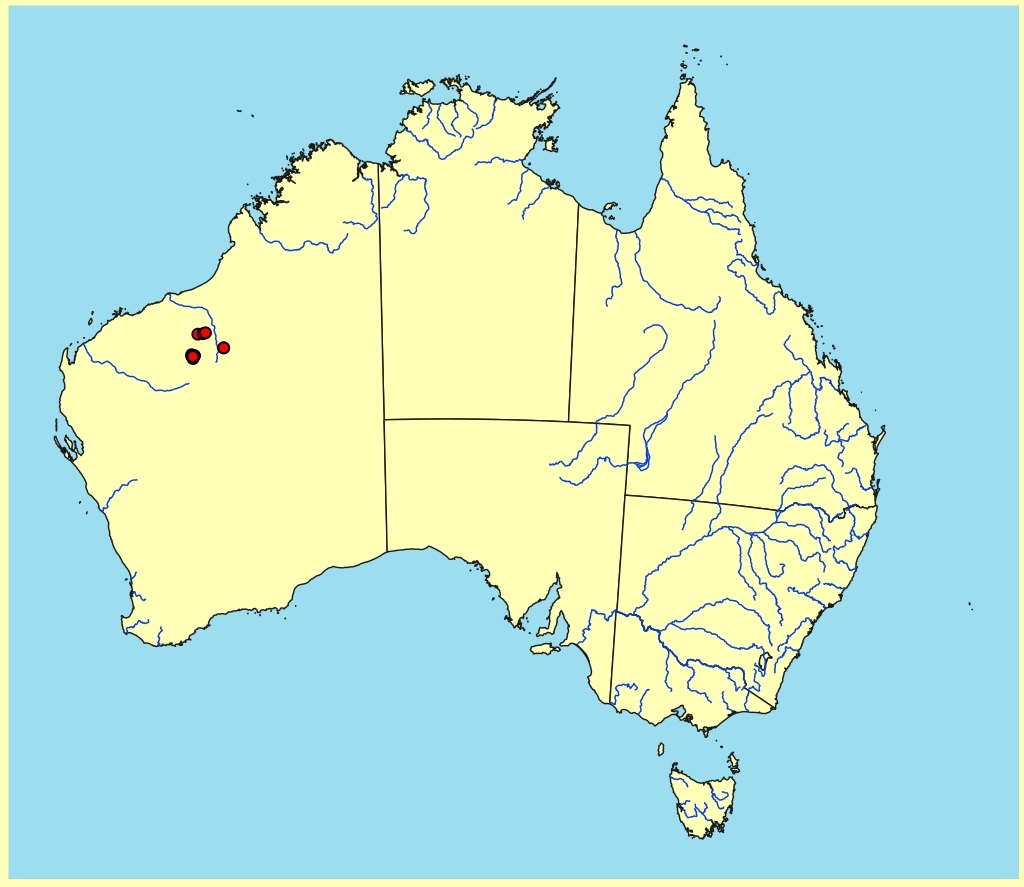Eucalyptus | Symphyomyrtus | Adnataria | Apicales | Buxeales | Amissae
Euclid - Online edition
Eucalyptus rowleyi
Eucalyptus rowleyi D.Nicolle & M.E.French, Nuytsia 22(1) 25-28 (2012).
T: Western Australia: north of Newman towards Roy Hill [precise locality withheld], Brooker 8327, 1 November 1983; holotype PERTH; isotypes: AD CANB.
Mallee to 5 m tall. Forming a lignotuber.
Bark smooth throughout whitish, pale grey to pale orange and tan.
Branchlets lacking oil glands in the pith; not glaucous.
Juvenile growth (coppice or field seedlings to 50 cm): not seen.
Adult leaves alternate, petioles 1–2 cm long; blade lanceolate, 7.5–14.7 cm long, 1–2.5(3) cm wide, base tapering to petiole, margin entire, apex pointed, concolorous, dull but when fully mature glossy, green to slightly blue-green, side-veins at an acute or wider angle to midrib, reticulation dense, intramarginal vein remote, oil glands conspicuous, intersectional.
Inflorescence terminal compound, but occasionally single umbels in upper leaf axils also, peduncles thickened 0.4–1.2(2) cm long, buds 7 or 9 per umbel, pedicels thickened angular 0.15–0.6(1) cm long. Mature buds obovoid, 0.5–0.6 cm long, 0.3–0.5 cm wide, scar present (outer operculum lost early in bud development), operculum broadly conical to rounded, stamens inflexed, the outer filaments without anthers (staminodes), inner filaments fertile, anthers more or less cuboid, adnate, basifixed, dehiscing by sub-terminal pores, style long and straight, stigma blunt, locules 3 or 4(5), the placentae each with 4 vertical rows of ovules. Flowers creamy white.
Fruit pedicellate (pedicels 0.15–0.6(1) cm long), barrel-shaped to weakly urceolate, 0.5–1 cm long, 0.4–0.7 cm wide, disc descending, valves 3 or 4(5), enclosed or just below rim level, rim thickish.
Seeds brown, 1–2 mm long, ovoid to flattened-ovoid, dorsal surface shallowly reticulate, hilum ventral.
Cultivated seedlings (measured at node 10): not grown; data from Nicolle & French (2012)cotyledons reniform; leaves dull blue-green, not waxy, ovate to 10 cm long, 6 cm wide.
Flowering has been recorded in November.
A low mallee endemic to Western Australia, restricted to the northern Pilbara region and Little Sandy Desert, extending north-east from near Roy Hill to the Oakover River east of Balfour Downs and towards Nullagine. Habitat is hard red soil on flat lowland sites. Plants have smooth bark and a crown of dull leaves which become glossy green at maturity, cylindrical to barrel-shaped fruit, sometimes contracted a bit below the rim, borne on thickened angular pedicels.
In the classification of Brooker (2000) the more recently published Eucalyptus rowleyi would belong in Eucalyptus subgenus Symphyomyrtus section Adnataria because the buds have two opercula, ovules are in four rows, seeds are flattened-ovoid, cotyledons are reniform, and anthers are rigid on the staminal filaments. Within section Adnataria, E. rowleyi is part of a subgroup, series Buxeales (the boxes), further distinguished by being partially rough-barked, having terminal inflorescences and buds that lose the outer operculum early. Most species in series Buxeales are found in south-eastern Australia, with only six occurring in Western Australia, viz. E. cuprea, E. absita, E. normantonensis, E. lucasii, E. aridimontana and E. rowleyi.
All six western species have inflexed stamens the outermost of which lack anthers (staminodes), features separating them to some extent from the eastern species. Both E. absita and E. cuprea occur further south in better watered areas. E. normantonensis is found north and east of the distribution of E. rowleyi, and has extensive rough bark, chocolate brown smooth bark and smaller buds and fruit.
Eucalyptus rowleyi was split from E. lucasii, along with E. aridimontana, by Nicolle & French (2012) thus: E. lucasii fully formed adult leaves always dull bluish green, fruit with slender angular pedicels the angles not extending to body of fruit; E. aridimontana fully formed adult leaves ultimately glossy, green, fruit barrel-shaped with two angles extending from base of fruit down the thickened pedicel; E. rowleyi ultimately with glossy green broad adult leaves and more or less cylindrical to barrel-shaped or weakly urceolate fruit on thickened angular pedicels the angles extending onto the fruit. E. lucasii and E. rowleyi both occur on similar low hard flood-out country whilst E. aridimontana is restricted to mountaintops and ridges on ironstone at altitudes greater than ca 900 m.
Eucalyptus rowleyi: after Bruce Rowley (1940–), desert traveller, who first encountered the species in the Little Sandy Desert of Western Australia.






